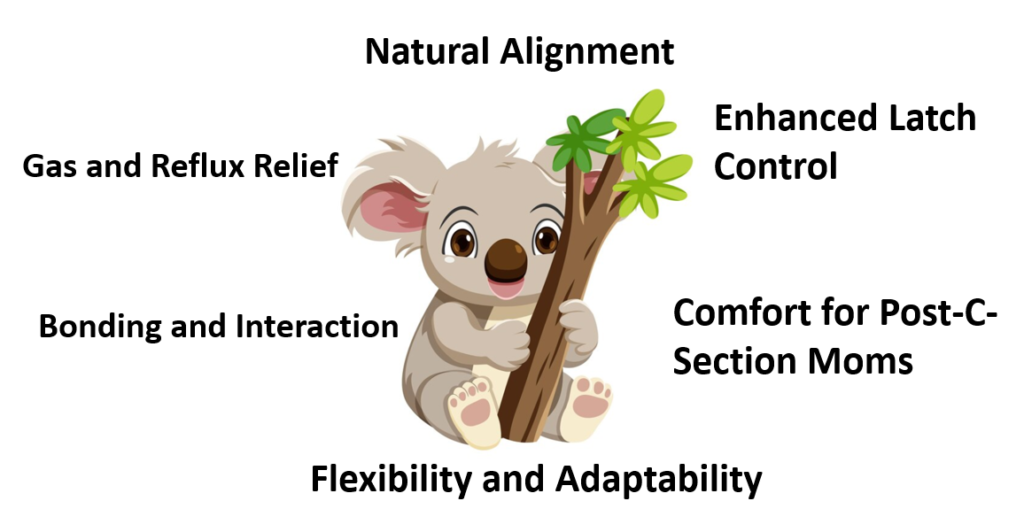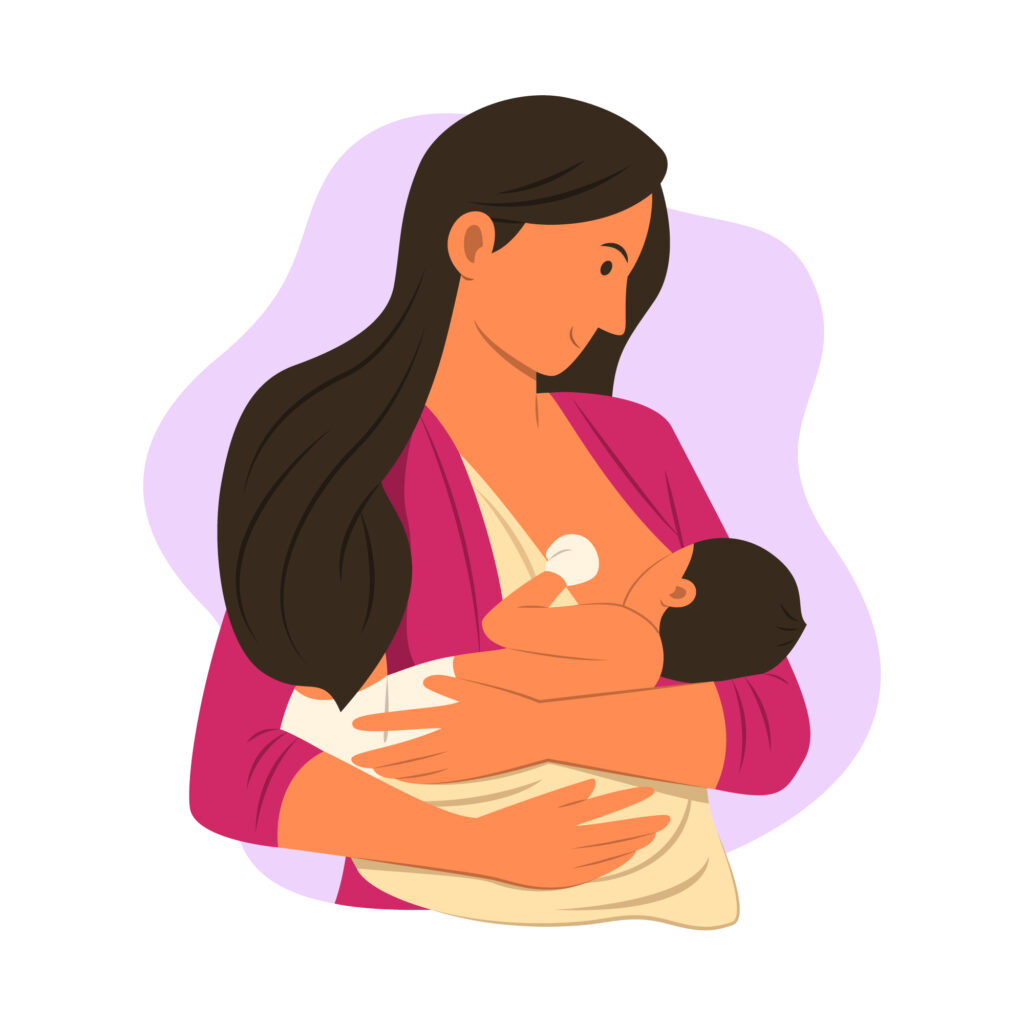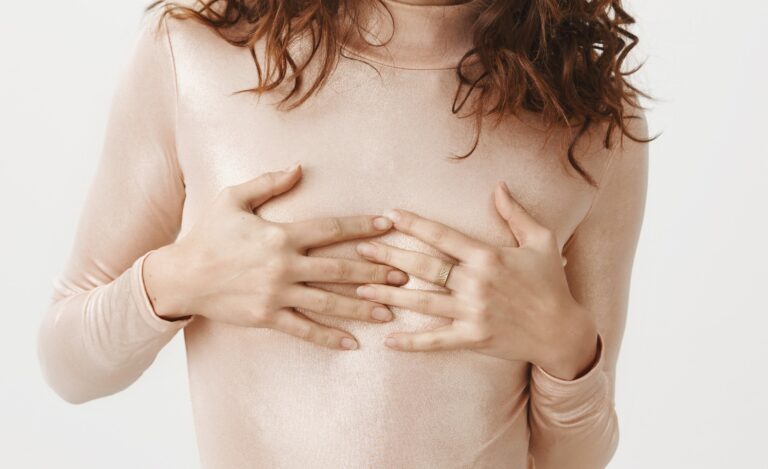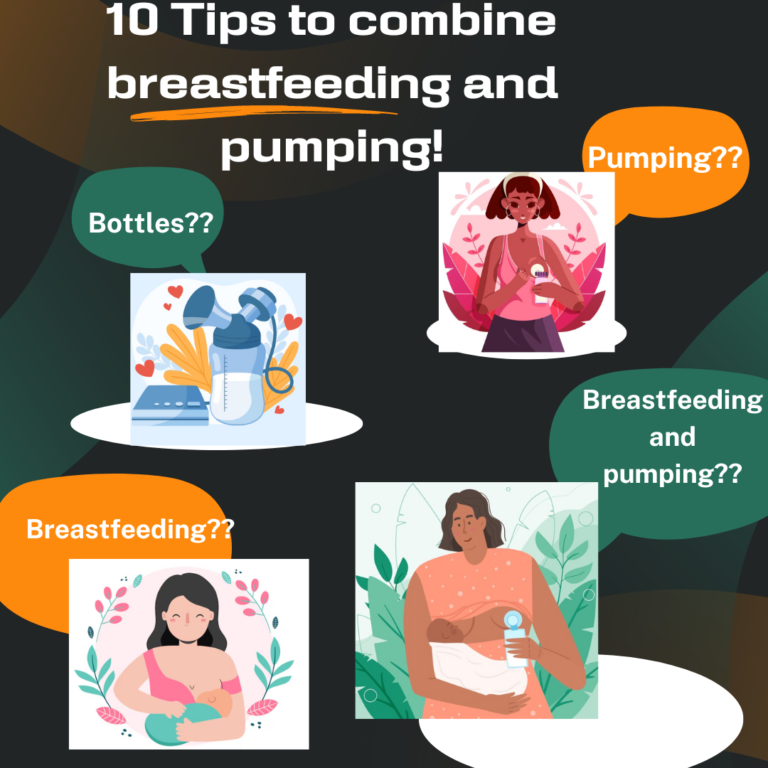Mastering the Koala Hold: The Ultimate Breastfeeding Position for Newborns

As a new mother, finding the perfect breastfeeding position can be both crucial and challenging. One position that has gained significant attention and praise from the past decades is “The Koala Hold“.
It is also known by another name, “the Vertical Hold”. This method offers numerous benefits for both the baby and the mother. In this article we will discuss about Koala hold in detail, and will also discuss step-to step process of this breastfeeding position.

What is a Koala Hold and Its Alternate Name?
The Koala Hold, or the Vertical Hold, is a breastfeeding position that mimics the way a koala bear holds onto a tree trunk—hence its adorable name.

This position involves holding your baby upright against your chest, with their head resting near your shoulder. The baby’s legs are positioned around your waist, much like a koala’s legs around a tree branch. This unique posture facilitates a more comfortable and effective breastfeeding experience.
Why the Koala Hold is the Best Breastfeeding Position for Newborns?
When it comes to nurturing your newborn through breastfeeding, finding the right position can make a world of difference in both your comfort and your baby’s feeding experience.
The Koala Hold, emerges as a frontrunner among breastfeeding positions for a myriad of compelling reasons. Let’s delve into why the Koala Hold stands out as the best choice for nurturing your little one:
- Natural Alignment: One of the most remarkable aspects of the Koala Hold is its emphasis on natural alignment. By holding your baby in an upright position against your chest, you’re mirroring the way they naturally rest against your body when carried. This alignment not only supports optimal digestion but also enhances the comfort and security your baby feels during feeding.
- Gas and Reflux Relief: Newborns often struggle with gas and reflux, causing discomfort and sometimes even interrupting their feeding. The Koala Hold is a game-changer in this regard. With your baby positioned upright, gravity assists in keeping milk flowing smoothly through their digestive system. This reduces the likelihood of milk traveling back up the esophagus, easing gas and reflux symptoms and leading to more peaceful feeding sessions.

- Enhanced Latch Control: Achieving a proper latch is vital for both the baby’s nourishment and the mother’s comfort. The Koala Hold excels in promoting an effective latch. With your baby’s head positioned near your shoulder, guiding them to latch onto your breast becomes more intuitive. This can help prevent nipple soreness and ensure your baby is receiving the right amount of milk.
- Comfort for Post-C-Section Moms: Mothers recovering from a cesarean section often face unique challenges when it comes to breastfeeding positions. The Koala Hold offers a significant advantage in this scenario. By holding your baby upright against your chest, you reduce pressure on the incision area, making feeding more comfortable and facilitating a faster recovery.
- Bonding and Interaction: Breastfeeding is a profound opportunity for bonding between a mother and her baby. The Koala Hold amplifies this connection by allowing your baby to be in close proximity to your face, facilitating eye contact, gentle touches, and even soft conversation. This nurturing interaction fosters a deep emotional bond that extends beyond mealtime.
- Flexibility and Adaptability: The beauty of the Koala Hold lies in its adaptability. Whether you’re sitting, standing, or even walking, you can comfortably maintain this position. This flexibility is especially valuable for busy mothers who may need to multitask or those who want to remain engaged with their surroundings while feeding.
- Versatility for Feeding Options: While the Koala Hold is widely associated with breastfeeding, it’s also a fantastic option for bottle-feeding. The benefits of upright positioning remain consistent regardless of whether your baby is nursing from the breast or a bottle.
Whether you’re seeking relief from feeding-related discomfort, a deeper bonding experience, or a versatile feeding option, the Koala Hold is the ultimate solution that continues to earn its reputation as the best breastfeeding position for newborns.
Does the Koala Hold Help with Gas While Breastfeeding? How?
Yes, the Koala Hold is a highly effective breastfeeding position for addressing gas-related issues in newborns. This unique position provides several mechanisms that work together to alleviate gas discomfort during and after feeding.

Let’s explore how the Koala Hold helps with gas and why it’s so effective:
- Upright Position: This upright posture allows gravity to assist in the natural movement of gas bubbles upwards, preventing them from getting trapped in the baby’s tummy and causing discomfort.
2. Digestive Pathway: When your baby is in the Koala Hold, the alignment encourages a smoother path for milk to travel through their digestive system. The milk flows more naturally from the stomach to the intestines, reducing the likelihood of gas bubbles forming along the way.
3. Minimized Air Ingestion: Babies often swallow air while feeding, especially if they’re not latched properly or if they’re using a bottle. In the Koala Hold, the baby’s head is positioned near your shoulder, which can help prevent them from gulping air. This minimizes the amount of air entering their stomach, consequently reducing the potential for gas formation.
4. Easier Burping: Burping is an essential step after feeding to release any trapped air. The Koala Hold simplifies this process. Since your baby is already in an upright position, transitioning to a burping position requires minimal movement. Gently patting or rubbing their back can lead to quicker and more effective burping, expelling any gas that may have accumulated during feeding.
5. Comfortable Digestion: The Koala Hold promotes comfortable digestion. When your baby is in an upright position, the milk is less likely to pool in the stomach, reducing the chances of acid reflux. This contributes to a calmer and less colicky baby, as gas-related discomfort is minimized.
In summary, the Koala Hold’s effectiveness in addressing gas issues during breastfeeding stems from its combination of an upright position, optimized digestive pathway, reduced air ingestion, and facilitated burping.
How to Do the Koala Hold: Step-by-Step Guide
The Koala Hold, also known as the Vertical Hold, is a nurturing breastfeeding position that provides numerous benefits for both you and your newborn. Follow these simple steps to master the art of the Koala Hold and enjoy comfortable and effective breastfeeding sessions:

Step 1: Set the Scene for Comfort Find a quiet and comfortable spot to sit down.
Use cushions or pillows to support your arms, back, and the baby as needed. Make sure you’re in a relaxed position, allowing you to focus on your baby’s needs.
Step 2: Position Yourself Hold your baby close to your body in an upright position.
Your baby’s head should be nestled near your shoulder, and their face should be turned towards your breast. Ensure your baby’s body is facing you with their tummy against your chest.
Step 3: Support the Baby’s Head Gently.
Place one hand behind your baby’s head, supporting the neck and ensuring their head is free to move. Be careful not to press their head too firmly against your shoulder.
Step 4: Baby’s Legs and Bottom Placement
Allow your baby’s legs to wrap around your waist or hip area. Their bottom can rest on your forearm or the palm of your hand. This positioning mimics the way a koala’s legs wrap around a tree branch.
Step 5: Align for a Comfortable Latch
Ensure your baby’s mouth is aligned with your nipple. Wait for your baby to open their mouth wide, and then guide them onto the breast. This alignment ensures a proper latch, reducing the chances of nipple soreness.
Step 6: Support Your Breast
With your free hand, gently support your breast as needed. This provides additional assistance for your baby to latch comfortably and effectively.
Step 7: Feeding in the Koala Hold
Allow your baby to nurse while maintaining the Koala Hold position. As your baby feeds, you can use your supporting hand to guide their head and maintain the latch.
Step 8: Burping and Comfort After feeding
It’s important to burp your baby to release any trapped air. Simply hold your baby against your shoulder and gently pat or rub their back to encourage burping.
Tips and Considerations:
- Take your time (Practice makes perfect)
- Stay attentive
- Seek professional guidance
Remember, every baby is unique, and what works best might vary. The Koala Hold offers a nurturing and comfortable breastfeeding position that can help address gas and reflux issues while fostering a close connection between you and your baby.
Should I Consult My Doctor?
While the Koala Hold is generally safe and beneficial, it’s always a good idea to consult your healthcare provider before trying any new breastfeeding position. They can provide personalized advice based on your health, your baby’s needs, and any specific circumstances.
Conclusion
The Koala Hold, or the Vertical Hold, is a game-changer in the world of breastfeeding positions. Its unique benefits, from reducing gas and reflux to aiding post-C-section recovery, make it a top choice for nursing mothers seeking comfort and effectiveness. By following the simple steps outlined above and consulting your doctor if needed, you can master the art of the Koala Hold and enjoy a more fulfilling breastfeeding journey.
Frequently Asked Questions:
Is the Koala Hold suitable for premature babies?
Yes, the Koala Hold can be beneficial for premature babies, but it’s essential to consult your healthcare provider for guidance tailored to your baby’s specific needs.
Can I use the Koala Hold for bottle-feeding?
Absolutely! The Koala Hold’s benefits extend to bottle-feeding as well. It can help minimize gas and discomfort during bottle feedings.
Is the Koala Hold the only upright breastfeeding position?
No, there are other upright positions like the “Cradle Hold” and “Football Hold.” However, the Koala Hold’s unique features make it stand out, particularly for addressing gas and reflux issues.

















+ There are no comments
Add yours